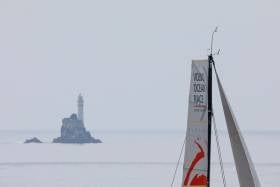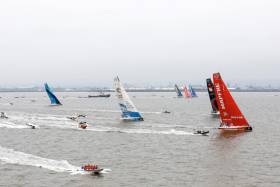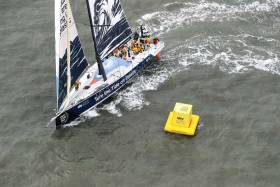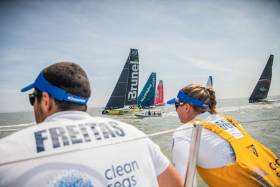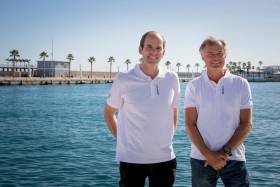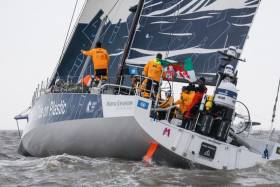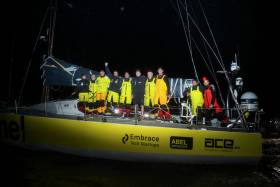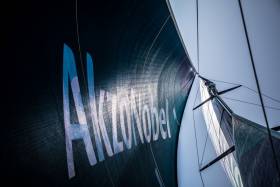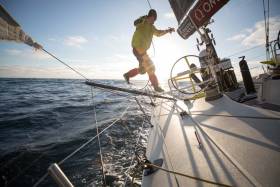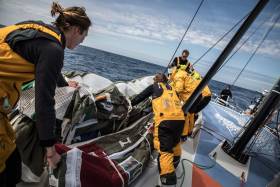Displaying items by tag: VOR
#VOR - The Volvo Ocean Race’s overall leaders Dongfeng Race Team were at the head of the fleet on Monday (11 June) as the teams passed the iconic Fastnet Rock off Ireland’s southern tip.
With just under 24 hours of Leg 10 complete, less than three miles split the top six boats as the light wind start to the penultimate stage of the race continued.
Since leaving the Welsh capital Cardiff on Sunday 10 June, the fleet has been dogged by fickle breeze, covering less than 250 miles at speeds of no more than 10 knots.
The only boat not enmeshed in the light airs on Monday afternoon is Team Sun Hung Kai/Scallywag, but David Witt’s team is some 77 miles behind the leaders after getting caught in the tide and being forced to anchor last night
Dongfeng, skippered by Charles Caudrelier, shot into the lead on Sunday evening after Leg 9 winners Team Brunel and rivals MAPFRE came to a halt in a patch of super-light breeze.
Although Dongfeng’s lead is narrow, Brunel skipper Bouwe Bekking said he is keen not to let them slip any further ahead.
At 1,300 miles, Leg 10 is the shortest of all 11 legs, but with just three points separating Dongfeng, MAPFRE and Brunel on the overall leaderboard, its significance is huge.
“After the start we wiggled ourselves nicely to the front, but then parked up together with MAPFRE,” Bekking said. “Dongfeng did the ‘Buffalo Girl’ coming from way behind and, keeping some pressure, slid into the lead.
“Luckily we got some breeze shortly afterwards and started making gains around the other boats. Slowly the breeze increased during the night and we had to make several sail changes, which were perfectly timed.
“We can see Ireland now and the wind is dropping, so the boats behind us will likely catch up, but so will we with Dongfeng.”
Less than three miles behind Dongfeng in sixth place, Vestas 11th Hour Racing were preparing to do everything possible to catch their rivals.
“We had a good start then all of a sudden everything was reversed,” Vestas 11th Hour Racing’s Jena Mai Hansen said. “Right now we can still see everyone, so we just need to give that little bit extra so we can catch them.”
After clearing Fastnet Rock, the fleet will pass Bull Rock and begin the turn right to start climbing up the west coast of Ireland in headwinds.
It’s a short leg but a technical one – with plenty of opportunities and plenty of hazards.
“This leg is complicated,” explained Turn the Tide on Plastic skipper Dee Caffari, who has Ireland’s own Annalise Murphy among her crew. “Lots of land on both sides, lots of headlands, lots of tidal gates and then some oil rigs and wind farms.
“It’s going to be a really busy job for the navigator, especially as we’re not going to be out of sight of the rest of the fleet the entire time. It’s pretty full on.”
The ETA into the finish in Gothenburg, Sweden is currently this Thursday night 14 June.
Leg 10 Position Report, Monday 11 June (Day 2) at 2.40pm Irish time/1.40pm UTC:
- Dongfeng Race Team – DTF 1,056.7 nautical miles
- Team Brunel +0.6 nautical miles
- MAPFRE +1.4
- Team AkzoNobel +2.2
- Turn the Tide on Plastic +2.8
- Vestas 11th Hour Racing +3.1
- Sun Hung Kai/Scallywag +54.2
Volvo Ocean Race Fleet Prepares For Sunday Start In Cardiff
#VOR - With just two legs remaining in the 2017-18 Volvo Ocean Race, the battle for the overall prize is tighter than ever — with three teams fighting for first place and a fourth crew still in with a shot at the podium.
As the crews prepare for the start of the Leg 10 sprint from Cardiff, Wales to Gothenburg, Sweden this afternoon (Sunday 10 June), Charles Caudrelier’s Dongfeng Race Team has the advantage, sitting in pole position and coming off a last-minute win in yesterday’s In-Port Race.
The Chinese-flagged team holds a one point lead over Xabi Fernández’s MAPFRE, who had been leading for the majority of the race. And just two points further back is the hottest team in the race, Bouwe Bekking’s Team Brunel.
To put in context how dominant Bekking’s team has been over the past three legs, consider Brunel has scored 37 of the maximum 38 points available, compared to Dongfeng with 26 points and MAPFRE, who have collected 20 points over that span.
“All the pressure is on these guys, they’re still ahead of us,” Bekking said at Friday’s press conference. “We just have to beat them, like I said in Newport. Just beat the two red boats and then we’ll see what happens on the last leg. I think it will all come down to the last leg into The Hague.”
As much as he’ll be fighting for the prize, Bekking will need to keep one eye on his Dutch compatriots on team AkzoNobel, who could challenge for the podium with two strong results on the finishing legs.
For the leader, Charles Caudrelier, the emergence of Brunel as a threat has changed the way his team will approach Leg 10.
“Earlier in the race, maybe we played too much in match racing with MAPFRE,” Caudrelier said. “Now there is another boat in the game. We just have to go race and see what happens. Maybe after his leg we’ll have to think about controlling someone but right now, the lead is too small for that.”
Leg 10 is a 1,300-nautical mile sprint that takes the teams around the west coast of Ireland up to the northern tip of Scotland before heading east-southeast to Gothenburg, the home of Volvo.
Leg 10 of the Volvo Ocean Race starts at 4pm this afternoon. Catch a live stream of the action at the Volvo Ocean Race website or on Facebook Live, and join the conversation on Twitter before the start.
Volvo Ocean Race Leaderboard after Leg 9:
- Dongfeng Race Team – 60 points
- MAPFRE – 59 points
- Team Brunel – 57 points
- Team AkzoNobel – 48 points
- Vestas 11th Hour Racing – 36 points
- Sun Hung Kai/Scallywag – 29 points
- Turn the Tide on Plastic – 26 points
#VOR - The top three teams in the In-Port Race Series for the Volvo Ocean Race held down the podium positions on Friday afternoon (8 June) in Cardiff, as Dongfeng Race Team made a pass on the last lap of the race course to claim the win.
“We’re very happy. It’s always a pleasure to win the In-Port Race,” said skipper Charles Caudrelier. “I think we are making good progress on the inshore racing and for the team this is good for our morale ahead of the next two legs.”
The overall leader in the In-Port Series, Xabi Fernández’s MAPFRE, limited the damage on the points table with a second-place finish, while Bouwe Bekking’s Team Brunel battled all afternoon to secure third place.
Conditions were good for racing, with wind near 10 knots and racing taking place in moderate currents during the turn of the tide. A large spectator fleet was on hand to enjoy the competition.
In the moments before the start gun fired, it was apparent Vestas 11th Hour Racing was vulnerable. Close to the line with too much time to kill, Charlie Enright’s team was pushed over the line early by Team Brunel.
A split on the first leg of the course saw Simeon Tienpont’s Team AkzoNobel lead at the top mark and hold on to that advantage for two laps of the race.
But on the second downwind leg, Caudrelier’s Dongfeng Race Team closed up on the run and split from AkzoNobel to the favoured side of the race course for the final upwind leg.
When the boats converged again near the top of the course, Caudrelier was in a strong position to tack directly ahead of AkzoNobel, to extend into a healthy lead for the run to the finish.
“I think we had very good speed today and we were able to tack and put them in our bad air and then he lost a lot,” Caudrelier explained.
Indeed, it was a painful moment for AkzoNobel, who were pushed back all the way into third place, behind MAPFRE as well, before being passed by Brunel on the final run, eventually settling for fourth in a race the team had led for two laps of the course.
Vestas 11th Hour Racing fought back for a fifth place finish ahead of David Witt’s Sun Hung Kai/Scallywag and Dee Caffari’s Turn the Tide on Plastic.
If anything, the competition today was a preview of what is in store on the final two legs of the Volvo Ocean Race.
Just three points separate Dongfeng Race Team (60) from MAPFRE (59) and Team Brunel (57) on the overall race leaderboard. All three teams were battling with intensity for a podium finish on Friday.
And all three teams have their sights firmly set on winning the next leg into Gothenburg to ensure they are in position to secure the race win on the final sprint into The Hague at the end of the month.
Should there be a tie on the overall race leaderboard at the end of the offshore legs, the In-Port Race Series standings will be used to break the tie. After today’s results, MAPFRE retain a considerable advantage in this respect.
Leg 10 of the Volvo Ocean Race starts at 4pm this Sunday afternoon 10 June.
Current Volvo Ocean Race In-Port Race Series Leaderboard:
- MAPFRE – 56 points
- Dongfeng Race Team – 49 points
- Team Brunel – 41 points
- Team AkzoNobel – 39 points
- Vestas 11th Hour Racing – 26 points
- Sun Hung Kai/Scallywag – 21 points
- Turn the Tide on Plastic – 17 points
#VOR - It’s getting tense now as we reach the stage in the Volvo Ocean Race where every single point counts.
The top three teams in the race are heading into the final two legs separated by just three points on the race leaderboard.
After racing over 40,000 nautical miles, Charles Caudrelier’s Dongfeng Race Team — the new overall race leader — is ahead of the Spanish MAPFRE team by just one point, with Leg 9 winners Team Brunel two points further back.
The tight overall race leaderboard is bringing the In-Port Race Series standings into focus.
Should there be any ties on the overall leaderboard at the conclusion of the Volvo Ocean Race in The Hague, then the final position of the teams at the In-Port Race Series will act as the tie-breaker.
MAPFRE, skippered by Xabi Fernández, currently holds the tie-breaking trump card, sitting at the top of the leaderboard for the series, with three race wins and four second place finishes to boast the most consistent podium results.
Eight points behind is Dongfeng Race Team, winners of three in port races, but held back in the series standings by one disappointing result in the China stop.
The two Dutch-skippered entries, Team AkzoNobel and Team Brunel, are battling for the final podium spot, with Bouwe Bekking’s Brunel just one point ahead of Simeon Tienpont’s squad.
It’s all to play for with just three contests left in the In Port Race Series. The action starts in the Sky Ocean Rescue In Port Race Cardiff tomorrow Friday 8 June at 2pm.
As always, you can catch a live stream of the action at the Volvo Ocean Race website or on Facebook Live, and join the conversation on Twitter from 15 minutes before the start.
The VOR team will also be blogging all the moves, previews and news from the racetrack on the live blog, including the best of clips and social content, from 1.30pm. Find it at www.volvooceanrace.com under the ‘Racing’ section.
Current Volvo Ocean Race In-Port Race Series Leaderboard:
- MAPFRE – 50 points
- Dongfeng Race Team – 42 points
- Team Brunel – 36 points
- Team AkzoNobel – 35 points
- Vestas 11th Hour Racing – 23 points
- Sun Hung Kai/Scallywag – 19 points
- Turn the Tide on Plastic – 16 points
#VOR - Organisers of the Volvo Ocean Race have confirmed the next edition of the race will start in 2021 under new ownership — and the possibility of an added racing class.
Atlant Ocean Racing Spain – led by Richard Brisius, Johan Salén and Jan Litborn – will take over the Volvo Ocean Race from Volvo Group and Volvo Cars, the co-owners of the event for the past 20 years.
Brisius, Salén and Litborn have extensive experience in the premier round the world race, having worked with seven Volvo Ocean Race campaigns over the past 28 years.
Brisius and Salén started as sailors in the 1989-90 race, before finding success as team managers, including winning efforts with EF Language (1997-98) and Ericsson 4 (2008-09). Most recently, they managed Team SCA, the all-female entry, in the last edition of the race.
In November 2017, Brisius and Salén were named president and co-president of the current edition of the Volvo Ocean Race.
“The history of this round the world race is inspiring and the future is very promising,” said Brisius. “This race is about people and I am humbled by the prospects to serve some of the finest athletes and sport professionals in this world as well as leading partners to the race and host cities.
“I have been fortunate as many of my dreams have come true. First my dream to sail this race, then my dream be a team manager, followed by my dream to manage the race, and now the dream to be able to steer the future of the race.
“We are in this for the long run and we are determined that the race will go from strength to strength as a sustainable premier world event. I look forward to being part of evolving this unique race by co-operating together with the teams, cities, Volvo and all our key stakeholders.”
The organisers of the race are considering having two classes of boats racing in 2021, potentially with the existing Volvo Ocean 65 one-design class and another class, yet to be determined, competing in the same race.
“We are in this for the long run and we are determined that the race will go from strength to strength as a sustainable premier world event.”
“We will continue to innovate, and it is promising that from day one we can think long-term as we have the resources secured to deliver the next race already,” said Salén.
“Opening the race to another existing class would allow us to tap into an existing inventory of round the world race boats that are at the cutting edge of technology. We see this as a way to challenge the best sailors in the world with a class that encourages development and sits at the forefront of the sport.”
The current leadership group of the Volvo Ocean Race will continue to engage with stakeholders in the coming weeks to move the race to the next level commercially and from a sporting perspective with a view to sharing some more details by the end of this edition of the race.
While the next race will start in 2021, additional significant racing activity is expected to take place as early as possible to offer stakeholders an extended period of activation in the build-up to the start of the next race and to allow future teams the opportunity to build an extensive training programme.
Volvo Cars will remain as a sponsor of the 2021 race, while there is an ongoing conversation already with existing host cities and sponsors for the 2021 race and prior sailing activities.
“The Volvo Ocean Race has been a great vehicle for building customer relationships, strengthening the Volvo brand and presenting our company and our products to a global audience,” says Kina Wileke, executive vice president of Volvo Group Communication.
“After 20 years we feel that it is time to hand over responsibility for this prestigious competition to a new and capable owner with the experience and know-how needed to develop it even further,” says Björn Annwall, senior vice president at Volvo Cars. “Volvo Cars will continue to support the next edition of the race as a sponsor with special focus on sustainability.”
The 2017-18 edition of the race is scheduled to finish in The Hague on Saturday 30 June. The most recent leg finished on Tuesday 29 May, with Annalise Murphy’s Turn the Tide on Plastic placing sixth. Leg 10 from Cardiff in Wales to Gothenburg, Sweden sets sail on Sunday 10 June.
#VOR - Annalise Murphy’s Turn the Tide on Plastic received a heroes’ welcome despite a disappointing sixth-place finish in Leg 9 of the Volvo Ocean Race this morning (Tuesday 29 May), and skipper Dee Caffari found some bright spots to celebrate once the team was dockside.
“We had some of the best sailing the guys have done the entire race so they were buzzing,” Caffari said, referencing the record-breaking conditions mid-leg that saw some of the highest 24-hour runs in the history of the race.
“They have all now circumnavigated the globe and none of them had done that when we left. We have crossed our track from Leg 0, they’ve all gone round the world and I’m really proud of them.”
For Caffari, this race marks her fifth time around the world, including three non-stop circumnavigations.
For one of Annalise’s crewmates, Bleddyn Mon, the finish line in Wales represented a homecoming of sorts, as he grew up sailing in Anglesey.
“This is a day I’ve looked forward to from the beginning of the project,” he said dockside just after finishing. “For me, offshore sailing is quite new and I was in at the deep end with the Volvo Ocean Race … But I’ve learned so much about how to manage myself offshore.”
In addition to Caffari, the rookies on board Turn the Tide on Plastic can profit from the experience of another one of Britain’s most accomplished offshore sailors.
Navigator Brian Thompson became the first Briton to set the Round the World record twice and to sail non-stop around the world four times. He says he thinks the team has the ability and drive to earn a podium position on one of the remaining two legs.
“We’ve been so close on several occasions, Thompson said. “If you had taken the halfway point on some of the legs we’d have been on the podium or in the lead,” he noted.
“But I think we need a little bit of good fortune. We’re all getting better every leg… we’ve really learned how to sail the boat and we’re all getting more experience. So I think in the nice tactical close racing we can hold our own with everyone, so we’re looking forward to the last couple of legs.”
Leg 9 of the Volvo Ocean Race was won by Team Brunel, who are making a late charge for the top of the leaderboard. But Dongfeng Race Team are the new overall race leaders, just one point clear of MAPFRE and three points ahead of Brunel.
One boat remains racing at sea: Sun Hung Kai/Scallywag is expected to finish overnight tonight and into Wednesday morning (30 May).
#VOR - Turn the Tide on Plastic, with Annalise Murphy on board, finished sixth in Leg 9 of the Volvo Ocean Race across the Celtic Sea in Cardiff this morning (Tuesday 29 May).
Skippered by Dee Caffari, the Turn the Tide boat arrived at 08:56:21 UTC to complete the morning’s arrivals into Cardiff Bay, around two hours behind fifth-placed MAPFRE.
Caffari also marked a milestone for her rookie crew, who as of 12 hours ago — when the Leg Zero track was crossed — had circumnavigated the globe for the first time.
Earlier, skipper Bouwe Bekking’s Team Brunel won Leg 9 in the early hours of this morning, crossing the line seconds before 3.40am Irish time to vault into serious contention for the overall race win.
Since arriving in Auckland with a disappointing sixth place finish, the Dutch team has posted a 1-2-1 scoreline, including wins on the final two double-point scoring legs and moved from also-ran to a firm podium position with an eye on the top spot.
To get the leg win, Brunel's Bekking had to fend off fellow Dutch skipper Simeon Tienpont’s Team AkzoNobel, who held a nominal lead just hours before the finish.
But in the strong currents and light winds of the Bristol Channel, Bekking and his crew found a way to claw back in front and protected over the final miles to take the win by just four minutes and five seconds over the recent 24-hour-record breakers.
More importantly, Bekking has added 15 points to his overall score and moves his team within striking distance of the overall race lead with two legs to go.
“We’re very happy with the result – to beat the two red boats was the objective,” Bekking said after crossing the finish line. “Winning of course is nice to get the bonus point and then a nice fight to beat AkzoNobel in the end as well, so we’re a happy team.
“But the aim is to keep looking forward. We’ve closed the gap to MAPFRE and Dongfeng and victory remains our main objective!”
Team Brunel are now just three points off the overall race lead, with two short legs to go to the finish in The Hague three weeks away.
Third over the line were Dongfeng Race Team, about an hour and a half behind the leaders but enough to move three points ahead of Team Brunel and take the overall race lead by a single point from MAPFRE, who arrived in fifth place just before 7.50am Irish time.
“It’s nice, but it’s a very small lead to MAPFRE and now Brunel as well who are making a fantastic comeback,” Dinging skipper Charles Caudrelier said dockside after the finish. “So it’s going to be interesting for fans to follow as the race is far from finished. The level is very even and it’s a big fight for every place … we would have preferred an easier finish!”
While Brunel has been ascendant on the last three legs and Dongfeng consistently among the leaders, MAPFRE roared out to a fast start in the opening legs, but has struggled of late.
“It hasn’t been an easy leg for us. It’s been painful from day one and we never could catch up,” said skipper Xabi Fernández. “But looking forward we feel confident. Hopefully we can start well and fight boat to boat over the next two legs.”
Scoring a fourth place finish on the leg was Charlie Enright’s Vestas 11th Hour Racing. The team has prided itself on its podium finishes, but this leg marks its worst result across the finish line in the race.
However having missed three crucial legs in the middle of the race, the team’s position on the overall leaderboard is all but locked in at fifth place.
“It was a disappointing leg from a results standpoint, but that doesn’t take away from what was a good crossing for the team,” Enright said. “We’ve overcome a lot more than just a bad result in this race and now we have two legs left to put our best foot forward and end on a good note.”
The arrivals are expected to complete tonight when last-placed Sun Hung Kai/Scallywag are due.
Leg 9 Position Report, Tuesday 29 May (Day 10) at 10am Irish time/9am UTC:
- Team Brunel – Arrived 02:39:53 UTC
- Team AkzoNobel – Arrived 02:43:58 UTC
- Dongfeng Race Team – Arrived 04:16:12 UTC
- Vestas 11th Hour Racing – Arrived 05:09:09 UTC
- MAPFRE – Arrived 06:49:52 UTC
- Turn the Tide on Plastic - Arrived 08:56:21 UTC
- Sun Hung Kai/Scallywag +126.2
#VOR - Less than a mile separated Volvo Ocean Race Leg 9 frontrunners Team Brunel and Team Akzonobel on Monday (28 May) as the teams prepared to enter the final 100 miles.
After almost eight days of intense racing across the Atlantic from Newport, USA to Cardiff, Wales, the leading pair were today neck and neck.
To add to the intensity, third-placed Dongfeng Race Team — desperate to avenge their Leg 8 result when they were forced off the podium into fourth in the final few hours — were just 11 miles from the front.
With winds dropping to under 10 knots, an anxious, slow-motion finish is on the cards for Leg 9 as the teams try to pick out the quickest route to Cardiff, with at least four teams in play for the leg win.
While the lack of breeze isn’t helping, the real challenge will be to navigate the tidal current the fleet will encounter in the Bristol Channel.
If a team is fortunate enough to arrive in the channel at the right time, they could be rocketed towards the finish line. If they get unlucky, they could face up to six knots of adverse current sweeping them back out to sea.
It makes for a tense time for the sailors but especially the navigators, tasked with directing their crews through the tactical minefield.
At the front of the fleet, veteran Volvo Ocean Race navigators Andrew Cape (Brunel) and Jules Salter (Akzonobel) were preparing to face off for Leg 9 glory.
“We’re into the last 24 hours and neck and neck with Brunel,” AkzoNobel’s Emily Nagel said. “The wind is going to be up and down, there will be plenty of tacks and we’re not going to get much sleep. It’s going to be a real tactical battle, especially for Jules.”
While Dongfeng remain in touch with the leaders, Vestas 11th Hour Racing in fourth were almost 30 miles behind while overall race leaders MAPFRE were 60 miles back in fifth.
A podium result for Dongfeng could see them usurp MAPFRE from the top of the overall scoreboard with just two short legs remaining.
But in trademark style, skipper Charles Caudrelier said his team were focused on overhauling the two Dutch boats ahead of them and scoring their first leg win.
“Our dream is to have a leg win and get revenge for Leg 8,” Caudrelier said. “Brunel and AkzoNobel have sailed well from the start but now they’re fighting together there’s a chance they could make a mistake if they get too caught up with each other.
“They have a good lead now but it could be reduced to nothing by the time we get to the bay. The problem isn’t the wind, it’s the current, but we have a plan, and I think it’s a good one.”
Despite little opportunity in the weather forecasts for an overtaking move, Xabi Fernández’s MAPFRE crew vowed to keep fighting until the Leg 9 finish line.
“We’re in pretty big trouble now – Vestas 11th Hour Racing are 30 or 40 miles ahead of us and the other guys even further,” crewman Blair Tuke said.
“We were hoping there was going to be some sort of compression but it doesn’t look like that’s going to happen.
“It’s going to be light, but the guys in front won’t completely stop. It’ll be difficult to catch them, but we’ve got 24 hours to go and we won’t give up.”
The latest ETAs see the leading pair arriving after 3am Irish time early tomorrow, Tuesday 29 May, with the remaining boats arriving throughout the day.
Leg 9 Position Report, Monday 28 May (Day 9) at 4pm Irish time/3pm UTC:
- Team Brunel – DTF 81.9 nautical miles
- Team AkzoNobel +0.7 nautical miles
- Dongfeng Race Team +17.5
- Vestas 11th Hour Racing +30.8
- MAPFRE +66.2
- Turn the Tide on Plastic +91.7
- Sun Hung Kai/Scallywag +210.9
#VOR - Team AkzoNobel and Team Brunel were racing practically neck and neck on Sunday (27 May) as the Volvo Ocean Race fleet geared up for a nail-biting Leg 9 finale.
With less than 300 miles remaining to the finish line in Cardiff, Wales, the two Dutch boats were just two miles apart at the front of the seven-strong fleet and matching each other for speed.
Having broken free of the clutches of a high-pressure ridge west of Ireland that halted their fast progress across the Atlantic, the fleet faces one last hurdle – a cyclone off Land’s End, the most westerly point of England.
The depression will force the teams to sail upwind, tacking to take what they believe is the quickest route to the finish line. There will be an enhanced emphasis on tactics, sail selection and above all team work on the final miles to the finish.
Having had victory snatched from them at the last minute in Leg 8, Brunel are out to exact revenge on rivals MAPFRE and Dongfeng Race Team by defeating them in Leg 9.
At 2pm Irish time, Dongfeng were 32 miles behind them in third, with MAPFRE in fifth some 87 miles off the pace.
Brunel’s veteran skipper Bouwe Bekking said that with the two red boats taken care of, his crew would then set their sights on overhauling AkzoNobel in pursuit of their second leg win this edition.
“The finish looks tricky – we have to manage a low-pressure system just off Land’s End, England that means upwind sailing and tacking eventually, then one more park-up before sailing into the finish,” Bekking said.
“We expect Dongfeng will push hard south east as it’s their only way to have a chance to gain mileage on us. But it can be tricky for them as well – if they get caught in the low, it means no pressure.
“We can’t control them if we’re sailing in a different weather pattern, so we can’t think too much about that. We have to make the right moves for what is the best for us.
“Objective number one for this leg was, and is, beating the two red busses, so that hope for overall victory is still alive.
“Let’s make that happen first and we feel we can pass the leader as well.”
AkzoNobel were equally fired up for the final fight in Leg 9. “We’re ready for a long match race, potentially all the way to the finish line,” AkzoNobel’s Chris Nicholson said. “Everyone’s up for it.”
As well as the regular battle between the seven teams, a personal scrap between the race’s two Welsh sailors – Bleddyn Mon on Turn the Tide on Plastic and Trystan Seal on Sun Hung Kai/Scallywag – has developed, with each looking for bragging rights sailing into their home country.
“There are two Welshmen in the race and the race is on between them. We have Bleddyn Mon and Scallywag have Trystan Seal and we are racing to bring a local hero home,” said Dee Caffari, skipper of sixth-placed Turn the Tide on Plastic.
“I am sure both will be Welsh celebrities by the end of the stopover but this is now about bragging rights and we need to find our victories somewhere, however large or small.”
The Race Village in Cardiff officially opened on Sunday morning. The Welsh city becomes just the third port in the UK to host the Volvo Ocean Race, after Southampton and Portsmouth.
Current ETAs have the leading group finishing late tomorrow night and into the early hours of Tuesday morning (29 May), with the rest of the fleet following throughout the day.
Leg 9 Position Report, Sunday 27 May (Day 8) at 3.39pm Irish time/2.39pm UTC:
- Team AkzoNobel – DTF 281.5 nautical miles
- Team Brunel +1.8 nautical miles
- Dongfeng Race Team +29.3
- Vestas 11th Hour Racing +57.7
- MAPFRE +81.1
- Turn the Tide on Plastic +130.6
- Sun Hung Kai/Scallywag +263.5
#VOR - The leading boats in the Volvo Ocean Race have left yesterday’s record-breaking conditions in their wake as they bump into a ridge of high pressure that is beginning to slow their progress towards the finish in Cardiff, via Fastnet off Ireland’s South Coast.
The Leg 9 leader on Saturday 26 May is Team AkzoNobel, the crew still basking in the afterglow of setting a new 24-hour distance record for the Volvo Ocean Race.
Skipper Simeon Tienpont’s team smashed the old Volvo Ocean 65 record run of 550.8 nautical miles, then broke through the 600-mile barrier to provisionally claim the outright race record with a 24-hour run of 602.5 miles.
“I would have bet the house you couldn’t do 600 miles on one of these boats,” said watch captain Chris Nicholson. “I’m so happy for the whole team. It’s really cool. Everything had to align perfectly to break the record … what an effort!”
Regrettably, the team can’t spend much time celebrating. Already the strong-to-gale-force winds that pushed the fleet into record-breaking territory are easing and the leaders are starting to feel the effects of a high pressure ridge standing between them and the finish line.
“There is a big, big light spot ahead of us,” explained Dongfeng Race Team skipper Charlles Caudrelier from his third place position, nearly 30 miles back of the front runners.
“Unfortunately for the leader there is a wall of no wind. I don’t think anyone will cross it as it will move with us and we will have to wait and we’ll have a new start, all together. So I imagine there will be a big compression…”
At noon Irish time, the leading pair — Team AkzoNobel and Team Brunel — were only seeing 3 to 5 knots of wind, and watching helplessly as their hard-won advantage on the ranking started to plummet.
At 5pm on Friday afternoon, for example, Dongfeng Race Team was 62 miles behind AkzoNobel. By noon today, the margin was barely 25 miles, by 4.25pm it was under 4 miles — and the compression is expected to continue.
This is good news for those at the back, although there is a chance the leading pair break through the ridge and find favourable winds on the other side while the rest of the fleet is mired in the light and variable conditions.
“At the moment the ridge is stationary and that may allow a couple of the leaders to punch through it,” explains Brian Thompson, navigator on Annalise Murphy’s boat Turn the Tide on Plastic, still some 60 miles from the lightest conditions.
“But just as we get into it, it’s going to start to move back towards the UK and we’ll only be able to go the speed that it’s going. That’s going to be particularly frustrating for our team, but there will be other boats in the same predicament and we’ll be fighting with them to get out of this ridge and into the good wind on the other side.”
The light conditions mean that even though Team AkzoNobel now has less than 600 miles to run to the finish – a number they’ve just sailed in 24 hours – it will in fact take closer to three days to reach Cardiff.
Current ETAs have the leading group finishing in the early hours of Tuesday morning 29 May, with the rest of the fleet finishing throughout the day.
Leg 9 Position Report, Saturday 26 May (Day 7) at 4.25pm Irish time/3.25pm UTC:
- Team AkzoNobel – DTF 586.5 nautical miles
- Team Brunel +1.1 nautical miles
- Dongfeng Race Team +13.9
- Vestas 11th Hour Racing +16.0
- MAPFRE +52.5
- Turn the Tide on Plastic +34.7
- Sun Hung Kai/Scallywag +54.0


























